Download Full Version in PDF (EN)
The final conclusions of the Sixth Assessment Report of the Intergovernmental Panel on Climate Change (IPCC) were released on the 20th of March 2023.[1] It integrates the work conducted for the past five years on the Physical Science basis, Adaptation and Mitigation by the AR6 Three Working Groups, and the three special reports on limiting warming to 1.5°C, Climate Change and Land, and the Ocean and the Cryosphere. This synthesis provides the extent of science and knowledge we have on climate change from its causes, its impacts and its perspectives on the solutions. Because they translate science into concrete and quantified political objectives, IPCC statements are always significant milestones for global climate actions. With the next IPCC working cycle to begin in July 2023 for the next five to six years, the AR6 Synthesis Report is the primary piece on climate change to refer to for the forthcoming climate discussions, including COP28. This commentary will analyse the glimpse it gives into climate futures, and decrypt its key takeaways.
Climate change is human-made, already affecting (extreme) weather patterns everywhere and in an incommensurable extent to the regions that have contributed the least to global warming.
When it comes to policy analysis, the first step is to conduct a review of what we already know about the discussed issue. In order to understand the extent to which climate change is a problem, it is imperative to evaluate what it means at the present time. Assessing the current status of climate change is the primary analysis of the IPCC. This is also what this first section intends to do: understanding what climate change is, and how it materialises today.
Global warming is the result of the skyrocketing emission of greenhouse gases (GHG) in the atmosphere since 1750 and the advent of the first industrial revolution, which has intensified further after 1970, and even more since 1990. In 2011-2020, the global earth temperature was 1.09°C warmer than in 1850-1900, out of which 1.07°C is assessed to be directly caused by human activity.[2] Between 1900 and 1970, the global earth temperature increased at a rate of 0.06°C per decade, and then rose between 1970 and the 2010s at a level of 0.16°C per decade.[3]
Increasing occurrence and severity of extreme weather events - droughts, flooding, wildfires, heavy precipitation, sea level rise, ocean acidification and hot extremes - are among the negative climate changes observed due to global warming. They, in turn, disrupt natural and human ecosystems such as seasonal timing, food and freshwater availability, and particularly agriculture and aquaculture production. Global warming therefore affects species, human wellbeing, mental and physical health, and endangers critical infrastructures.[4]
Although the intensification of fossil-fueled human activity is to blame for climate change, it is not humanity as a whole that is responsible for it: the problems posed by global warming highlights the deeply unequal world we live in. In 2015, a study from OXFAM revealed that the top 10% of the wealthiest people globally accounted for 50% of global GHG emissions.[5] On the other hand, 50% of the poorest people in the world were responsible for 10% of global emissions. According to Lucas Chancel, an economist specialising in global inequalities, the responsibility of climate change is unevenly distributed between developed and developing countries, but also between the wealthy population and the poorest within a country.[6] Indeed, 10% of the richest Europeans emit about 30 tonnes of CO2 per person per year, while 50% of the poorest emit around 5 tonnes per capita. Similarly, the use of limited and natural resources is also unequal: a recent study has shown that 13.7% of the richest population in Cape Town, South Africa, captures 51% of the municipal water resources.[7]
However, the countries that have contributed the least to global warming - the developing countries and the least developed countries - are being impacted more by adverse climate effects. Climate change acts as a “threat multiplier” on pre-existing socioeconomic challenges.[8] Because less advanced economies deal with anterior development obstacles, they are less capable of digesting climate change effects, thus hindering both security and stability. Given the strong adverse impacts of climate change on food and water security, the least developed – namely from Africa, Asia, Central and South America, Small Islands and the Arctic – are vulnerable places, affecting mainly “the indigenous communities, small-scales food producers and low-income households".[9] A blatant example of climate injustice is that “between 2010 and 2020, human mortality from floods, droughts and storms was 15 times higher in highly vulnerable regions [to climate change], compared to regions with very low vulnerability”.[10]
Climate justice is also deeply intergenerational. As temperatures will continue to increase, leading undeniably to the intensification of adverse climate change effects, babies born after the 2020s will be more likely to experience harder climate conditions than past generations. With this in mind, climate change is therefore deeply affecting mental health, perceptions of the future, and reshaping societal norms, particularly in places where climate effects are felt the hardest. In 2021, a survey conducted with 10.000 people aged between 16 and 25 years old in ten countries[11] revealed that because of climate change, 75% of respondents see the future as frightening, and 39% are hesitant about having children - 48% in Brazil and 47% in the Philippines.[12] Furthermore, according to UNICEF, climate anxiety leads to hesitations about creating a family, which is higher in the Middle East and North Africa and sub-Saharan Africa than in the rest of the world.[13]
Our climate futures will depend on actions we are executing at the present time, and on how much we invest to tackle climate change effects and its root causes at a local, national, regional and international level.
Because of the cumulation of greenhouse gas emissions, the window of opportunity to maintain the global temperature below +1.5°C is tiny and can only be effective under a very low greenhouse gas emissions pathway. The IPCC predicts with a level of probability of 40 to 60% that this threshold will be attained by 2030.[14] The IPCC uses the models of the Shared Socioeconomic Pathways (SSP)
|
What are the SSPs ? The Shared Socioeconomic Pathways are scenarios used by the IPCC since 2021 determining socioeconomic developments through the 21st century. They include socioeconomic data such as population growth, urbanisation. They are used to determine the level of GHG emissions that could derive from such a scenario.[1] According to Carbon Brief, there are five of them: - SSP1 is the most optimistic scenario with a shift to sustainability and low challenges to mitigation and adaptation. - SSP2 is one of the intermediate scenarios, with medium challenges to mitigation and adaptation. - SSP3 is also an intermediate scenario based on the rise of nationalism and competition between States, leading to high challenges to mitigation and adaptation. - In the SSP4 scenario, there are rising inequalities between the rich and the poor, leading to low challenges to mitigation but high challenges to adaptation. - SSP5 is the most pessimistic scenario, with no shift in our GHG pathway, high challenges to mitigation and low challenges to adaptation. Source : Hausfather Z., « Explainer: How ‘Shared Socioeconomic Pathways’ explore future climate change », Carbon Brief, April 2018 |
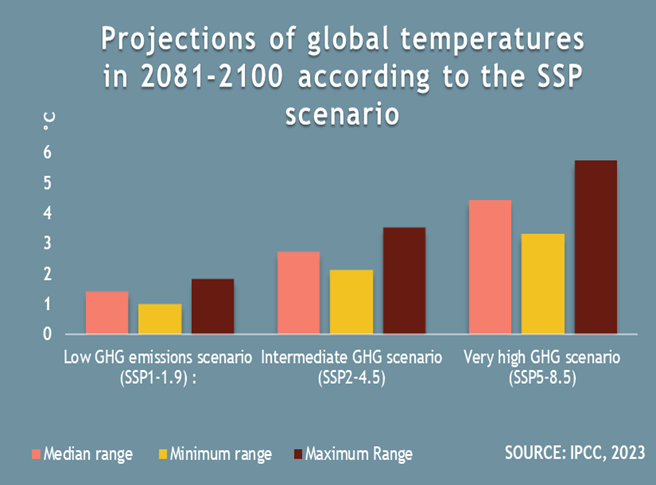
The IPCC message here is clear: as long as greenhouse gases continue to be emitted, global warming will keep rising.[16] This means that the decisions that are taken today to reduce the level of GHG we will emit as of now, will determine the extent to which the world will experience more harmful climate conditions. The more the earth warms, the more the risks associated with climate change increase: any rise in the global temperature by a mere tenth of a degree will have widespread consequences on our ecosystems and societies, and increase the risk of irreversible impacts.
The adverse effects of climate change will not be purely environmental – they will multiply other threats and collide with other pre-existing political, social, economic and security issues, leading to more complex domino threats. For instance, under a scenario of a 3.3-4.8°C increase, the distribution of maize production on earth will change, and could decline from 3 to 30% in Central America and by more than 35% in the Middle East (notably in Egypt and Iraq),[17] which will affect food security in all dimensions (availability, access and utilisation).[18] Another example concerns water security. The projected decline of water availability is not due only to climate change effects: it also takes into account other trends climate will interact with, such as demographic growth, mismanagement, and socioeconomic development.[19] Under a pessimistic scenario, the amount of freshwater available in the Middle East and North Africa region could shrink by 41% by the 2050,[20] but climate change effects will not be the first driver to water shortages; the socioeconomic changes mentioned above will be the main factors.
But even under a low-emission pathway, containing climate change does not mean that its effects will instantly disappear. Some damages, such as rising sea levels, are now permanent: for the next 2000 years, sea levels should keep increasing by two to three meters if warming is contained at +1.5°C by 2100[21]. The most vulnerable places to experience irreversible damage include forests, coral reefs and the Arctic regions. Since the 2000s for instance, because of the compounding effects of climate change and deforestation, about three-quarters of the Amazon forest has been losing resilience, increasing the risk of forest decline.[22]
What are the solutions? Mitigation is key to solving the climate crisis: net zero CO2 emissions is an imperial necessity and implies rapid and profound emissions cuts in every sector before 2030.
Although the IPCC recognizes that mitigation policies have been expanding across the globe, they are still insufficient to contain global warming at the level agreed upon in the COP21 Paris Agreements.[23] Indeed, under the current adopted Nationally Determined Contributions, the GHG emissions pathway for 2030 is projected to increase global temperatures to a level of 3.2°C by the end of the century.
Because of the extent of cumulative emissions in the atmosphere, only reaching net-zero emissions will limit warming to +1.5 or +2°C. If the 2019 CO2 emissions level remains stable during the decade 2020-2030, the historical accumulation of emissions will lead to an irreversible increase to 1.5°C.[24] However, between 2011 and 2020, global investments in climate finance were lower than subsidies distributed to support fossil fuel energies by fifty-one countries - including countries from the G20the most polluting economies in the world.[25] . In 2021, the largest economies in the world were also the main polluters : among the twenty most polluting countries, eighteen are part of the G20 [map below]. To achieve a net-zero future, this trend must be reversed urgently.
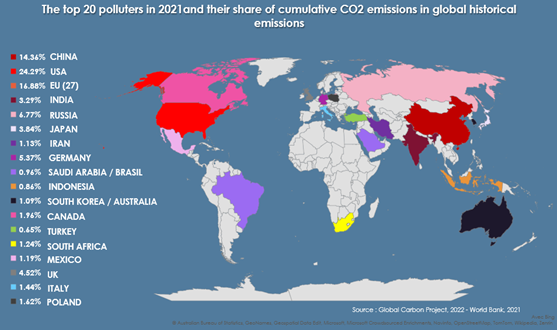
In 2019, only four economic sectors were responsible for the emission of nearly 80% of greenhouse gases: energy, industry, transport and buildings.[26] Greater efforts from public and private actors to curb their gas emissions are central steps to contain further unmanageable increases in the earth’s temperatures, especially by enhancing more ambitious sectoral climate policies.[27] Mitigation efforts have proved to have positive impacts on containing emissions: in 2022, the use of renewable energies across the planet prevented the emissions of 230 million tonnes of CO2, the equivalent of 49 million petrol-fueled cars.[28]
In 2019, only four economic sectors were responsible for the emission of nearly 80% of greenhouse gases: energy, industry, transport and buildings.26 Greater efforts from public and private actors to curb their gas emissions are central steps to contain further unmanageable increases of earth’s temperatures, especially by enhancing more ambitious sectoral climate policies.27 Mitigation efforts have proved to have positive impacts on containing emissions: for instance, in 2022, the use of renewable energies across the planet prevented the emissions of 230 million tonnes of CO2, the equivalent of 49 million petrol-fueled cars.
As the International Energy Agency clearly states: “renewables play a key role in clean energy transitions and the deployment of renewable power is one of the main enablers of keeping the rise in average global temperatures below 1.5°C”.[29] While the share of renewables in the global power mix increased from 19.8% in 2010 to 28.7% in 2021, it must attain a level of 60.9% in 2030 for a net-zero pathway, meaning an annual increase of 12% between 2022 and 2030.[30] Solar energy generation has increased over the past year, and is currently the cheapest electricity generation source, but should still increase by about 25% annually until 2030 for a favorable low-carbon energy scenario.[31]
Achieving this level of power generation from renewables by 2030 therefore requires strong and rapid investments in mitigation, without delay. Since the onset of the Covid-19 pandemic, followed by the global energy crisis, governments have increased their spending on clean energies: in July 2021, the investments amounted to 380 billion US$, but they reached 1.215 billion US$ in November 2022.[32] However, 95% of this rise comes from advanced economies, mostly from the United States – notably under Inflation Reduction Act – and the European Union. International climate finance must also raise its investments in supporting developing countries with mitigation policies and the green transition.
The more temperatures increase, the less adaptation options that will be effective in the future. To enhance more effective adaptation and to avoid maladaptation, more finance and knowledge should be allocated.
As for mitigation, the IPCC estimates that the planning and implementation of adaptation to climate change has been extending and improving across the globe, “generating multiple benefits”: around 170 public actors, states and municipalities have been including adaptation in their climate policies.[33] However, the IPCC also notes several adaptation gaps; notably, sufficient lack of finance for developing countries and a lack of planning, leading to maladaptation.
Adaptation measures are usually sectoral, which means that they are, in some instances, lacking overview, leading to inescapable maladaptation. Maladaptation refers to projects of adaptation to counter climate change effects that create, on the contrary, even greater vulnerability.[34] Maladaptation can result in policies that turn the population targeted initially as more vulnerable to climate change effects, or can refer to policies with unexpected negative externalities on another community.[35] In particular, it affects marginalized communities. For example, in Vietnam, the population living in the mountains has seen their access to the land constrained by policies aimed at improving forest protection, or by the construction of hydroelectric dams, that were in the first attempt planned for adaptation.[36]
According to the IPCC, “key barriers to adaptation are limited resources, lack of private sector and citizen engagement, insufficient mobilization of finance (including for research), low climate literacy, lack of political commitment, limited research and/or slow and low uptake of adaptation science, and low sense of urgency”.[37]
Distribution of green finance between 2016 and 2020
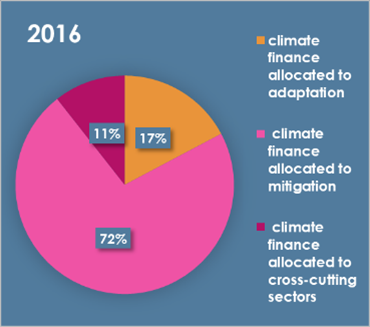
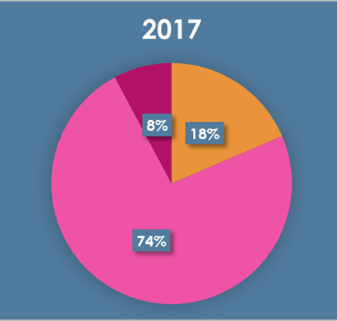
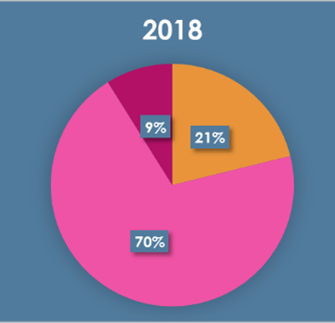
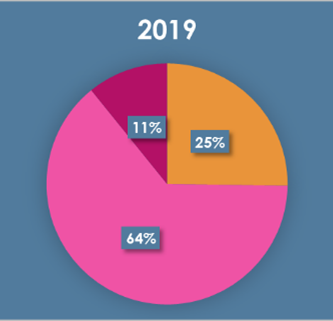
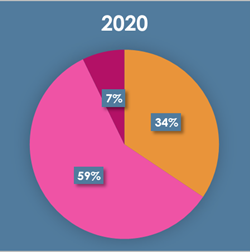
This lack of adaptation to climate change is particularly prominent in developing countries. This is partially due to gaps in climate aids from developed countries, which tend to allocate more finance for mitigation purposes. While the targeted amount of 100 billion US$ to be mobilised to support sustainable development in developing countries is still yet to be reached, finance for adaptation is falling particularly short.[38] Indeed, in 2020, although it increased compared to the level of 2016, the share of climate finance for adaptation reached less than 35% of total international finance allocated for climate change.[39] Distribution of finance towards developing countries has also been very uneven between continents between 2016 and 2020, with Asia receiving 42% of climate finance, while the Americas only 17%. In the same period, the most vulnerable states to climate change – the fragile States, the least Developing Countries and the Small Island Developing States – received 22%, 17% and 2% of global climate finance respectively.
The IPCC warns that along with the increasing temperatures, the need for greater adaptation will be required. However, in the meantime, the more ecosystems will experience higher temperatures and climate disruptions, the more they will attain limits in adaptation, and the hardest it will be to limit losses and damages – irreversible effects from climate change that cannot be reversed with mitigation and adaptation policies.
Conclusion: Our window of opportunity for a climate-proof future is getting tighter, and really depends on the political choices we make today.
The main message of the final IPCC report is that climate mitigation policies should go hand in hand with increasing knowledge on effective adaptation actions. Without mitigation, adaptation efforts on ecosystems will soon be limited. But because of cumulative GHG emissions, some climate change effects will permanently be felt. In the same way climate change is purely a human problem, the solutions must also come from changes in human activities. Mitigation policies are key to a low-carbon pathway. As we are getting closer to a +1.5°C scenario in the 2030s, the decisions taken - or not taken - in this decade will determine the future pathway of climate change for the rest of the century.
The window of opportunity is therefore narrowing, yet it is not too late. It requires massive financial investments and strong political ambitions for rapid emissions cuts and adaptation processes to achieve the green transition in all sectors. In other terms, securing our climate future will be determined by the level of political and global willingness of policy-makers in the coming years, and their ability to allocate the right resources, and to implement decisive, inclusive and effective climate governance.

